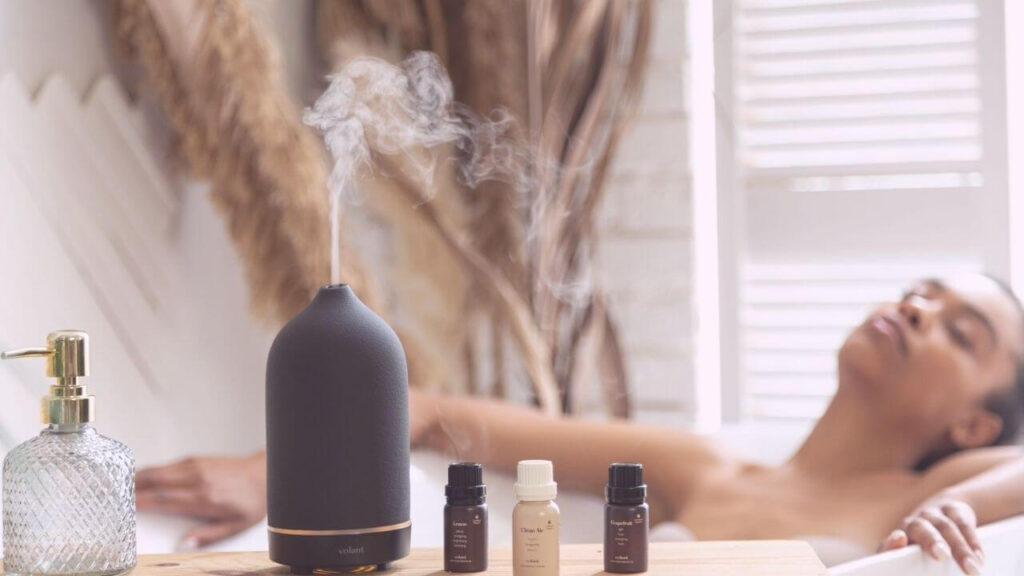When we were testing different essential oils, we often wondered how they work on the brain when used for aromatherapy. It seems that many people are also curious about this, given the increasing popularity of essential oils for relaxation, mood improvement, and stress and anxiety reduction in recent years. In our analysis, we found that one of the most common ways of using essential oils for aromatherapy is by adding them to a hot bath and letting their aroma fill the air.
Aromatherapy has been proven to be an effective method for improving mood and inducing relaxation. Different types of essential oils can target specific areas of the brain that control different emotions, depending on the oil being used. In our testing, we have tried using different essential oils to achieve different effects.
In this article, we will delve deeper into the science behind how essential oils work on the brain. We will explore how the scents we inhale can impact our emotions and improve our well-being. If you want to learn more about the fascinating world of aromatherapy and essential oils, read on!
There are three types of essential oil application
To better understand how essential oils affect the brain, it’s important to first discuss the various ways they can be applied. In our testing, we have found that there are three main methods of using essential oils: inhalation, massage, and ingestion. Each method has its own benefits and drawbacks, and the choice of method ultimately depends on personal preference.
The first method, inhalation, involves dispersing the scent of the oils using diffusers or aromatherapy candles. This is a popular way of using essential oils for relaxation, stress relief, and other mood-related benefits. In our analysis, we have found that inhaling essential oils can be particularly effective in targeting the olfactory system, which is closely linked to the limbic system, the part of the brain responsible for emotions and memories.
The second method, massage, involves applying the oils directly to the skin through a thorough massage. This method can be beneficial for targeting specific areas of the body and providing relief for muscle tension or pain. When we were testing this method, we found that it can also help the oils penetrate the skin and enter the bloodstream more quickly, providing faster relief.
The third method, ingestion, involves using the oils in cooking or adding them to food. However, we must caution that this method should only be attempted under the guidance of a trained professional, as ingesting essential oils can be potentially dangerous if not done correctly.
In summary, there are multiple ways to use essential oils, and each method has its own benefits and drawbacks. When we tried different methods of application, we found that inhaling and massage were the most effective for achieving the desired mood-related benefits. However, it’s important to always use essential oils safely and according to best practices.

It’s crucial to know that all methods create the same effect on our bodies. The only difference between them is the way the essential oils will get into our system. This is done through our nose, the skin, or the gut. Let’s see more about the science behind it.
The science behind essential oils
the effects of essential oils on the brain, we found that regardless of the method of application, once the oil particles enter the body, they quickly enter the bloodstream and travel throughout the body. However, the most important destination for the oil particles is the brain, where they can interact with the limbic system.
The limbic system is a complex network of structures in the brain that play a critical role in regulating emotions, behavior, and long-term memory. It is also closely connected to our sense of smell, or olfaction, which is why inhaling essential oils is such a popular way to use them. When we tried this method, we found that the scent of essential oils can directly affect the limbic system and trigger the release of hormones like dopamine, serotonin, and endorphins, which can promote feelings of relaxation, calmness, and happiness.

However, not all essential oils are the same. The olfactory system is a highly complex mechanism that checks every air particle that enters the nose using specialized sensors. For example, the olfactory tubercle has 27 inputs and 20 outputs that help transfer information from the nose to other systems in the brain.
Through our analysis, we found that spending time in a room filled with the scent of your favorite essential oil can quickly affect your brain and trigger emotional reactions. This is because the scent of essential oils can quickly reach the brain and interact with the limbic system, triggering the release of hormones and promoting feelings of relaxation, happiness, and satisfaction.
What essential oils affect our brains the best?
We found that different essential oils have varying effects on the brain. The human olfactory system is capable of detecting up to one trillion different odors, and each one can leave a lasting impact on the brain.
To achieve specific goals, such as reducing stress or increasing energy, it’s important to choose the right essential oil. Lavender, for example, is known to promote relaxation, while peppermint can help boost dopamine and increase energy levels. Sandalwood is excellent for improving focus and concentration, while jasmine can enhance libido. If you’re experiencing headaches, lemon essential oil may provide relief.

With so many different options available, you can find an essential oil to suit your specific needs and mood. By inhaling the right scent, you can easily promote relaxation, increase focus, or boost your energy levels. Our analysis shows that essential oils are a powerful tool for enhancing overall well-being and improving mental health.
Conclusion
We discovered how essential oils manage to make significant changes in our feelings by simply exposing ourselves to the scent of particular plants’ oils. The science behind the aromatherapy methods is truly amazing.
When we were testing, we found that aromatherapy is a science that needs to be explored thoroughly. There are many aromatherapy and essential oil courses on the internet for everyone to learn more about them, so if you want to make the most of it, feel free to search for the best ones out there.
Our analysis shows that this article is what you need if you want to learn how essential oils get inside our system, how they affect the brain, and what essential oils are good for various issues. We also found out how these oils make changes and how to use them properly. If you want to know more, do follow the other topics we have covered in our blog.


Recent Comments